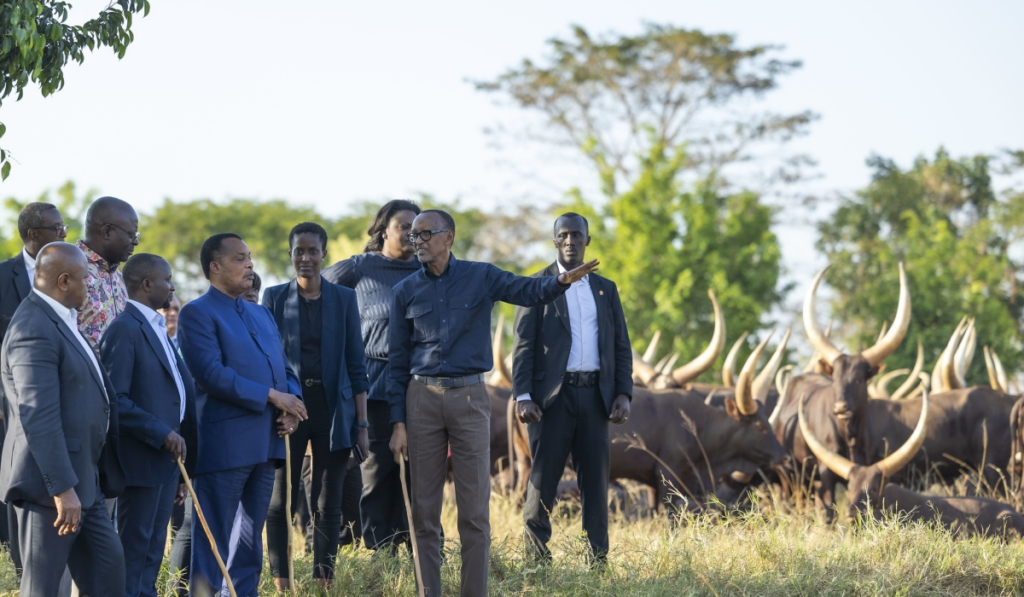Friday, August 4, 2023
It was good what last July 30 ‘The New Times’ termed: “Inyambo Diplomacy”. The daily went on to name the foreign leaders (and a son of one) whom President Paul Kagame has given this Rwandan special breed of cattle as gifts. The significance of it cannot be lost on the leaders because they must have understood what these elegant animals stand for in this land.
These ‘gracefuls’ stand for everlasting, constant renewal and multiplication of bonds. There’ll be renewal because as the gems continue to give birth, old ones will hand the baton to young cuties that will grow to get calves of their own, ad infinitum.
If by any misfortune these beauties were to be struck dead by any pandemic, tradition demands that President Kagame honour the obligation to console the bereft with a similar and equal re-offer.
This kind of forging close collaborations is certainly a novelty, even for a country like Rwanda that’s known for turning what’s always been an ordinary possession or occupation into an unlikely innovation.

In the history of Rwanda, Inyambo have never been thought of as a means to diplomatic ties.
If it were the old times, the recipients would go around swearing by President Kagame’s name, which is probably neither practical nor necessary today. But imagine the import of such a symbol in diplomatic terms. It fosters the above-mentioned and creates kinship that’d imply even readiness to come to the defence of one another at any cost.
Unlike inanimate things like minerals, their value is not in the wealth they can fetch. They are not seen in terms of animal products like meat or milk (an insult to them) but rather as animate splendours that could as well be presented on the catwalk. Material riches are no match to them. They are of exquisite grandeur; royalty far removed from the animal kingdom.
Unfortunately, there was a time in ancient days when these lovelies became a source of conflict. Some neighbouring countries were prepared to take Rwanda by surprise and snatch them away, considering her too inferior to be deserving of them. The others considered themselves superior.
So, the story goes that when Rwanda was engaged in defending one distant side of her borders, a neighbouring country overran the few guardians of one small herd of Inyambo and took them away as booty.
When news reached the Rwandan warriors at the frontline, they abandoned the defence line thereon and post-haste crossed their country (transport was legwork those days) to literally overrun the entire country on the other side of the border, to repatriate their treasure. Still, one or two remained and have since been appropriated (now grown in number) and given their own name – just as a river source has been – and presented to the world as its famed own.
But what’s a little superiority-complex-feeling tiff between ‘consanguines’!
The above apart, however, there are other breeds of cattle that are ordinary, like you’d have in any other country. These, like other livestock, are kept for a variety of consumption and other benefits.
In the Rwanda of ancient times, these so-called ordinary cattle also were a source of invaluable riches. They were therefore the pinnacle of propertied persons in terms of wealth, influence, strength, appeal, attraction to kinship and friendship as well as a magnate to service offer.
The cattle afforded their owners many privileges and though the owners tried to share them around to create a comradeship of equality, inequalities still existed among Rwandans.
When the colonialist arrived, this inequality provided a ready weapon to use in humiliating the owners of the cattle and to create a chasm between cattle-owner Rwandans and non-owners.
To humiliate the cattle owners, the colonialist planted the tsetse fly that killed off many animals and forced many owners to flee. Those who did not flee were forced into servitude to the colonialist which was enforced with ‘ikiboko’ (the hippo whip) and extended to all Rwandans.
Whether favoured by colonialists or not, the colonised were all herded into producing cash crops, some enforcing the labour while others actually labouring, to enrich colonialists’ countries of origin.
The strategy of divide-and-rule had hit the land and it succeeded beyond colonialists’ expectations.
Because after colonialism not only was a section of Rwandans killed or banished but also ownership of cattle was declared taboo and they were all killed off and eaten. This, though, did not stop the bigwigs of the regime from owning cattle in secrecy!
Then the 1994 liberation came and with it, Girinka. Girinka meant that the leadership of the country saw to it that every vulnerable family was given a cow to benefit from its capacity to improve nutrition. The first owner gave a calf to their neighbour in a giver-recipient chain of friendship unity. Before this, improved nutrition and other benefits had been the preserve of the rich.
Egalitarianism in Rwanda was emerging. Another novelty, considering cattle’s traditional place.
This together with other innovations has brought the Rwandan brand of democracy home to reign.
Western democracy-lecturers can keep their heckling democracy to themselves. Much good is it doing them!

